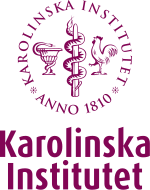Karolinska Institutet
 |
|
|
Former names
|
Kongl. Carolinska Medico Chirurgiska Institutet (1817-1968) |
|---|---|
| Motto | Att förbättra människors hälsa (Swedish) |
|
Motto in English
|
To improve human health |
| Type | Public |
| Established | 1810 |
| Endowment | 576,1 million EUR (2010) |
| Budget | SEK 6.2 billion |
| Vice-Chancellor | Karin Dahlman-Wright |
|
Administrative staff
|
4,976 (2014) |
| Students | 5,978 (FTE, 2014) |
| 2,071 (2014) | |
| Location |
Solna, , Sweden 59°20′56″N 18°01′36″E / 59.34889°N 18.02667°ECoordinates: 59°20′56″N 18°01′36″E / 59.34889°N 18.02667°E |
| Campus | Solna (Main) and Flemingsberg |
| Colors | KI Plum |
| Website | www |
 |
|
| University rankings | |
|---|---|
| Global | |
| ARWU | 44 |
| Times | 28 |
| Europe | |
| ARWU | 10 |
| Times | 8 |
Karolinska Institutet (KI, unofficially known as the Karolinska Institute and in English texts as the (Royal) Caroline Institute) is a medical university in Solna within the , Sweden, and one of the largest and most prestigious medical universities in the world. The Nobel Assembly at Karolinska Institutet awards the Nobel Prize in Physiology or Medicine. It consists of fifty professors from various medical disciplines at the university.
Karolinska Institutet was founded in 1810 on Kungsholmen on the west side of ; the main campus was relocated decades later to Solna, just outside . A second campus was established more recently in Flemingsberg, Huddinge, south of Stockholm. Karolinska Institutet consistently ranks among the top universities in the world on a number of prestigious ranking tables, and is currently considered the ninth best university to study medicine in the world.
Karolinska Institutet is Sweden's third oldest medical school, after Uppsala University (founded in 1477) and Lund University (founded in 1666). Research at Karolinska Institutet accounts for more than 40% of all academic medical research in Sweden.
The Karolinska University Hospital, located in Solna and Huddinge, is associated with the university as a research and teaching hospital. Together they form an academic health science centre. It is one of Sweden's largest centres for training and research, accounting for 30 percent of the medical training and 40 percent of the medical academic research conducted nationwide. While most of the medical programs are taught in Swedish, the bulk of the Ph.D. projects are conducted in English.
...
Wikipedia
